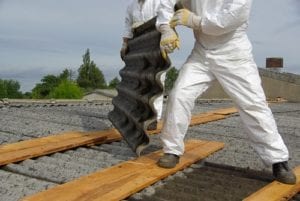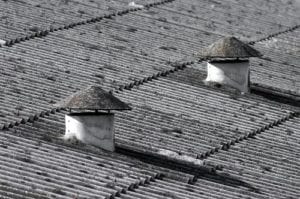Self asbestos removal
Removing asbestos is a dangerous job, yet there are many people who like to remove their asbestos themselves. Often, this has to do with saving costs. Leaving asbestos in place is no longer an option, now that it is clear that asbestos roofs must be compulsorily removed by 2025. Read this article to find out how to remove asbestos yourself, what costs are involved and which jobs are better left to others.
The cost of asbestos removal
Asbestos is a fibrous, non-combustible and heat-insulating substance, which has been banned in construction since 1993 due to its carcinogenicity. Whether you are allowed to start removing asbestos yourself depends on several factors. It is important that it is done properly because the substances released are very harmful to your health. To get a good idea of the asbestos removal cost per m2 when you do choose to have it professionally remediated, read the table below. Subsidies for asbestos removal are no longer available.
| Asbestos remediation project | Costs, incl. VAT |
|---|---|
| Asbestos removal | |
| – Corrugated sheets 1 – 10 m2 | £ 600 – £ 800 |
| – Corrugated sheets 11 – 20 m2 | £ 700 – £ 900 |
| – Corrugated sheets 21 – 30 m2 | £ 800 – £ 1.000 |
| – Corrugated sheets 31 – 50 m2 | £ 900 – £ 1,100 |
| – 1 room up to 35 m2 | £ 900 – £ 1,100 |
| – 2 rooms up to 40 m2 | £ 1.100 – £1,300 |
| – 3 spaces up to 50 m2 | £1,300 – £1,500 |
| – 2 spaces up to 70 m2 | £1.600 – £ 1,800 |
| Asbestos-containing material handling | |
| – Packaging for asbestos-containing material | £ 0 – £ 30 (suitable for 1.500 kg) |
| – Dumping asbestos-containing material | £ 0 – £ 25 per 100 kg |
Find the best specialist for your project and get free quotes.
Start

Self asbestos removal
In many cases, it is not allowed to remove asbestos yourself, but small amounts may be allowed. If not, you are obliged to request an asbestos inventory report and have the asbestos removed professionally. If you do not do this, high fines will follow. Removing asbestos yourself is allowed only when:
- The total area of the material does not exceed 35 square metres
- You are sure that no asbestos fibres are going to be released (you do not break any materials)
- If it is the adhesive-bound variant of asbestos
- You have filed a demolition notification with the municipality a week in advance
Either adhesive or non-adhesive
Adhesive asbestos you may therefore remove yourself, but how do you know if the asbestos in your home is bonded? By checking whether the material can be removed in one piece, without any material crumbling. Bonded asbestos is a type of asbestos where the fibres are firmly attached to each other. This is often the case, for example, with roofing sheets and imitation marble. Materials that often contain non-attached asbestos include insulation material and spray asbestos. Because it is a lot less solid, there is a greater chance of releasing asbestos fibres. So check carefully what type of asbestos you recognise before submitting a demolition notification to remove asbestos yourself.
Is it safe to remove asbestos yourself?
As long as you comply with the rules governing the removal of asbestos yourself, it is basically safe. Nevertheless, it is very important to do it very carefully. This is because there is always a high chance of microfibres being released that are harmful to your health. Make sure you put on good protective clothing and it is recommended for men to shave facial hair so that the mask fits the skin better. Adherent asbestos removal is safer than non-adherent asbestos removal, but due to its carcinogenic properties, it remains life-threatening. It is therefore advisable to hire a professional with all jobs involving asbestos removal. If you do not, you will still have to hire a company to collect and destroy your self-removed materials. As a private individual, you can also dispose of your asbestos at the local recycling centre in at least two layers of plastic film. However, this is not recommended due to breaking danger.

How to remove asbestos
There are three different methods for removing asbestos. Only the first method can be applied if you do decide to remove it as an individual, the other two methods can only be applied by specialists.
The outdoor method
Asbestos removal outdoors is the least manageable method of asbestos removal. It is therefore very important to pay close attention during the process. All materials must remain whole to prevent the release of asbestos fibres. For example, if you are removing corrugated asbestos sheets and a sheet does break, it must be treated with special substances. Consult a specialist for this and try to come into contact with the materials yourself as little as possible.
The containment method
As opposed to the open-air method, this method controls fibre emission best. This method can only be used in indoor areas. In this method, the asbestos specialist first determines exactly where the asbestos is and around this he or she builds a space with a special type of foil. Using equipment, the asbestos specialist then pressurises this space, releasing asbestos fibres. The equipment then immediately captures these fibres and this is how you get rid of the asbestos in your home.
The glove bag method
This method is more controllable than the open air method, but not as good as the contain method. The advantage of this method is that it can be applied indoors, as well as outdoors. In this method, the specialist first seals the source of the asbestos by means of an incubator bag. In this bag, the asbestos is released without danger, after which the specialist cleans it completely. The specialist wears a completely sealed suit for safety during the remediation.
When do you have an increased risk of asbestos?
There are certain cases where you are significantly more likely to have asbestos in your roof. This is only the case with houses built before 1993; after that, the use of this material was banned. If your house was built before 1993 and has a slate or bitumen roof, you have an increased risk of asbestos. If your house was built before 1994 and has a thatched or tiled roof, you can be sure you are asbestos-free. With corrugated sheets, you can tell by the code whether or not they contain asbestos. Is there an AT, NF or CAF code on your corrugated sheets? Then you can be sure there is asbestos in the roof. So the roof will have to be completely replaced. Often these are Eternit corrugated sheets; this company was the largest producer of asbestos. Is there an AF, NT, AFM, NA, AP or AV code on your corrugated sheets? Then they are asbestos-free. This information applies to the roofing of your shed and house.
Check your asbestos specialist
When you do or need to outsource the asbestos removal, it is important to be sure you are dealing with a good specialist. To check this, the Asbestos Certification Foundation Ascert has created a search engine where you can easily check whether a company is certified. Remediation companies bearing this quality mark work according to the legally required regulations.
Find the best specialist for your project and receive free quotes.
Start